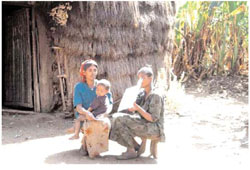Active surveillance
The second type of surveillance is called active surveillance, in which the health professionals actively seek to collect data from all possible cases in their area, under instruction to do so from a higher level in the health system. Active surveillance is usually conducted in relation to a specific disease or disorder, or it seeks to assess the takeup of a particular health service (e.g. family planning or immunization). Active surveillance data are collected because the higher health authorities request a specific surveillance report, instead of waiting for other primary health facilities to send them routine reports. In this sense, it is the opposite of passive surveillance.
Active surveillance can also be a type of event-based surveillance, which refers to unstructured data gathered from sources such as media reports, community concerns and rumours. For example, if there is a rumour about a measles outbreak in your community, you will be requested to report if there are any new cases of measles during a defined period of time.
You will then have to actively collect data about new cases of measles by making house-to-house visits in your catchment area and reporting back (figure below).
